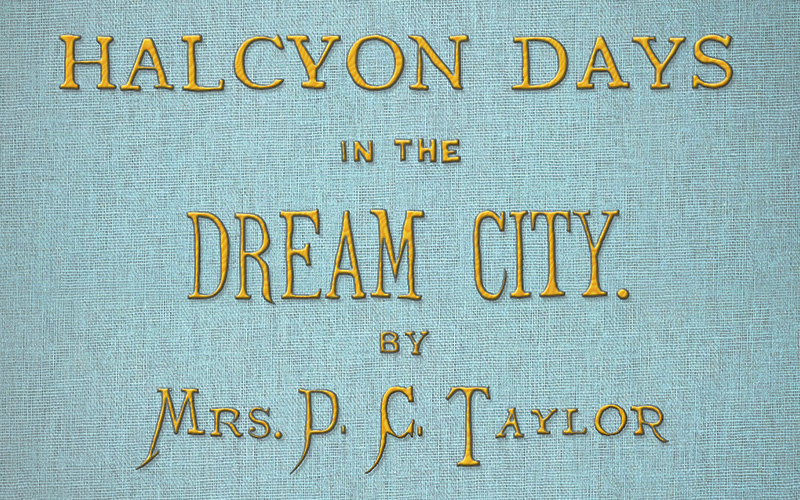Halcyon Days in the Dream City
by Mrs. D. C. Taylor
Continued from Part 5

This fine June morning we will go to Egypt without the tribulations of an ocean voyage and the fatigue of travel.
Walk up to this broad gateway, where a swarthy woman wearing a stick bound to the bridge of her nose and between her eyes, with a long black netted veil hanging from below them to her knees, is trying, with many blandishments, to sell flowers to the passers in and out. She coaxes in her soft southern language, offers to pin her pinks and roses in the gentlemen’s buttonholes, casts languishing glances through her thick black lashes, but the cold stolid American heart remains untouched, and while we look on she sells nothing.
We pay our entrance fees, pass through the gate, and walk up to the door of the “Temple of Luxor” which is guarded by a figure that looks as if it had stepped out of “Ben Hur.”[1] Inside we find a large, square, cold hall, paved with blocks of stone, the walls sloping upward and inward, embellished with strange paintings in flat tints of blue, red and black, without any attempt at perspective or grace of outline. Two rows of immense square stone pillars divide the hall in to three sections, and on two sides of every pillar stands a glass covered sarcophagus containing mummies of men, women and children, blackened and shriveled, with long bony arms crossed upon their breasts, and bare skulls, with deep hollow eye caverns, and jaws that seem to grin in fiendish glee upon us, as if they exulted in the knowledge that we, too, must sometime lie in naked ugliness, robbed of our robes of flesh.
The Temple of Luxor/Luksor on the Midway Plaisance of the 1893 World’s Fair. [Image from The Graphic History of the Fair. Graphic Co., 1894.]
We go around from one case to another, one enclosing the bones of Solomon’s sister-in-law, (What a host of them he must have had!) but come back to look at this hollow shell of what was once a mighty King. At the extreme end of the hall is a breast-high platform, which has a sort of low divan across the back. Seated upon this is a band of Egyptian musicians, and at either end of the platform sit two young girls with long black hair, long black eyes, and long noses too, with a strange charm in their dark faces, and wearing strange head dresses like tight-fitting, helmet-shaped caps of silk in brown and gold stripes, lying across their low brows and falling on each side of their faces in long square flaps, fringed with gold coins. One of the girls is playing upon a harp shaped like the bow of a vessel, with a great horn-like end rising far above her head. To the tinkling of the strings the other girl dances, swaying her lithe, slender body backwards and forwards in slow, graceful rythms, now and then giving a stamp with one sandaled foot. So dark-eyed maidens danced to such music, dressed in such garb, thousands of years ago, while majestic Pharaoh rested after the banquet; and so they dance to day, while Pharaoh sleeps, and the idle crowds pass by, gazing upon them and upon him, alike indifferent to both.[2]
Two women selling flowers in front of the entrance to the Temple of Luxor.
So we have seen all Egypt offers us here—the bare wide hall, the dancing girls, the long rows of sleeping forms in their glass coffins. Verily, the Temple of Luxor has not much to offer us, and we seek other scenes.
Continued in Part 7
NOTES
[1] The “Temple of Luksor” or “Temple of Luxor” was an attraction adjacent to the Street in Cairo and operated by the same concessionaires. There was, however, a separate 25-cent admission to the Temple.
[2] Like many visitors to this attraction, Mrs. Taylor does not appear to be aware that she is viewing reproductions and not authentic artifacts of ancient Egypt.

